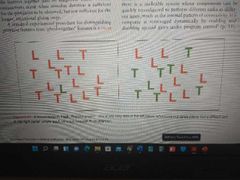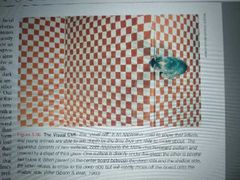![]()
![]()
![]()
Use LEFT and RIGHT arrow keys to navigate between flashcards;
Use UP and DOWN arrow keys to flip the card;
H to show hint;
A reads text to speech;
51 Cards in this Set
- Front
- Back
- 3rd side (hint)
|
Model of environment |
Humans require a continual update of images within or brains, then because if this humans perceive, make decisions and behave |
|
|
|
Five functions of perception |
Attention Localisation Recognition Abstraction and Constancy |
|
|
|
Perception |
Deals with the question of how organisms process and organize incoming raw sensory information |
|
|
|
Perceptual system - Attention |
Determining which part of the sensory environment to attend |
|
|
|
Perceptual system - Localisation |
Determining where objects are |
Localizing |
|
|
Perceptual system - Recognition |
Determining what objects are |
Recognizing |
|
|
Perceptual system - Abstraction |
Abstracting critical information from objects |
|
|
|
Perceptual system - Constancy |
Keeping the appearance of objects constant, even though their retinal images are changing |
|
|
|
Eye fixations |
When the eyes are relatively stationary. Each lasts approximately 300 milliseconds (about a third of a second). During these periods are when visual information is acquired from the environment |
|
|
|
Saccades |
Quick jumps or rapid jerky movement of the eye. These are very fast (on the order of 20 milliseconds). Vision is essentially suppressed during this time |
|
|
|
Abstraction |
Loss of information in the transformation from raw physical data to a percept |
|
|
|
Agnosia |
The general term for breakdowns or disorders in recognition |
|
|
|
Anterior system (for attention) |
Designed to control when and how the perceptual features (from the posterior system) will be used for selection |
|
|
|
Associative agnosia |
A syndrome in which certain patients cannot recognize visually presented objects |
Damage to the temporal lobe regions of the cortex |
|
|
Inattentional blindness |
Not seeing something because one is not paying attention to it |
Experiment by Simons and Chabris |
|
|
Change blindness |
Not noticing a major change in a visual stimuli that appeared a very short time ago (e.g., a second ago) |
Experiment by Simons and Chabris |
|
|
Analgesia |
The inability to feel pain |
|
|
|
Gestalt Psychology |

Gestalt's theory is "the whole is other than the sum of the parts." The human eye and brain perceive a unified shape in a different way to the way they perceive the individual parts of those shapes. E.g., grouping of dot patterns |
|
|
|
Binocular disparity |
Refers to the difference in the views seen by each eye |
Limited to objects that are relatively close |
|
|
Augmented network |
A network that includes inhibitory as well as excitatory connections |
|
|
|
Stroboscopic motion |

An illusion of motion resulting from the successive presentation of discrete stimuli patterns arranged in a progression corresponding to movement, such as motion pictures |
|
|
|
Selective adaptation |
This is a loss in sensitivity to motion that occurs when we view motion, the adaption is selective |
|
|
|
Binding problem |
How activity in different parts of the brain, corresponding to different primitives such as color and shape, are combined into a coherent perception of an object |
|
|
|
Global-to-local processing |
The means by which a scene aids in the perception of individual objects within a scene Global processing: understanding what the scene is - followed by Local processing: using knowledge about the scene to assist in identifying individual objects |
|
|
|
Feature integration theory |
A cornerstone of understanding object perception that was initially proposed by Anne Treisman. |
|
|
|
Visual search task |

In which the observer's task is to determine whether some target object is present in a cluttered display |
|
|
|
Dynamic control theory |
A theory that, instead of an early, hard-wired system sensitive to a small number if visual primitives, there is a malleable system whose components can be quickly recognized to perform different tasks at different times |
Alternative theory to "feature integration theory" |
|
|
Three types of cells in the visual cortex |
Simple cells Complex cells Hypercomplex cells |
|
|
|
Simple cells |

A cell in the visual cortex that responds to a line stimulus (such as a thin bar of light or straight edge between a dark and a light region) |
|
|
|
Complex cells |
A cell in the visual cortex that responds to a bar or edge, but it does not require that the stimulus be at a particular place. It will respond continuously |
|
|
|
Hypercomplex cells |
A cell in the visual cortex that responds to a particular orientation and length |
|
|
|
Top down processes |
Processes in perception, learning, memory, and comprehension that are driven by the organism's prior knowledge, experience, attention and expectations, rather than by the input |
Eg. You use previous memory of something, seeing a black object in the corner, thinking that it is a cat. You know that cats have a tail so you attend to the region of that object likely to contain the tail. You have prior knowledge of what a cat looks like and it's features |
|
|
Top down feedback connections |
Connections that go from the higher levels to the lower levels |
|
|
|
Bottom-up processes |
These are driven solely by the input - the raw, sensory data |
|
|
|
McGurk Effect |
Results from conflicting auditory and visual information |
|
|
|
Prosopagnosia |
A syndrome where a person is completely unable to identify faces but retains the ability to recognize objects. Results from brain injury in the right hemisphere |
|
|
|
Inversion effect |
Having extreme difficulty in recognizing faces but not objects when they are presented upside down |
|
|
|
Pure alexia |
Loss of the ability to recognize words |
Typically accompanied by damage in the left occipital lobe |
|
|
Available wavelengths |
The wavelengths of the light that is reflected off the paper reaching your eyes |
|
|
|
Source wavelengths |
The wavelengths provided by the source (coming from some light source) |
|
|
|
Reflectance characteristic |
Property of colored paper that determines how it reflects some wavelengths more than others |
|
|
|
Color constancy |
The ability of the visual system to perceive the reflectance characteristic, no matter what the source wavelengths. |
|
|
|
Posterior system (for attention) |
Represents the perceptual features of an object (such as it's location in space, shape, color). Is responsible for selecting one object among many on the basis of the features associated with that object |
|
|
|
PET (Positron Emission Tomography) |
An imaging test that allows your doctor to check for diseases in your body. Commonly used to detect: Cancer Heart problems Brains disorders, including problems with the CNS |
|
|
|
Primary visual cortex or V1 |
The most important region of the brain for visual processing |
|
|
|
Functional Magnetic Resonance Imaging (fMRI) |
Measures the sample changes in blood flow that occur with brain activity. Becoming the diagnostic method of choice for learning how a normal, diseased or injured brain is working. Examines the functional anatomy of the brain. Determine which part of the brain is handling critical functions such as thought, speech, movement and sensation, which is called brain mapping. Helps to assess the effects of stroke, trauma or degenerative disease Monitor growth and function of brain tumors |
|
|
|
Scotoma |
Blindness in very specific parts of the visual field |
|
|
|
Preferential looking method |
An infant's tendency to look at some objects more than at others |
|
|
|
Habituation method |
The fact that although infants look directly at novel objects, they soon become bored with the same object - that is, they habituate |
|
|
|
Visual acuity |
To be able to perceive an object, a person must first be able to discriminate one part of it from another |
|
|
|
Visual cliff |

Involved an apparent, but not actual drop from one surface to another |
Created by Eleanor J. Gibson & Richard Walk |

